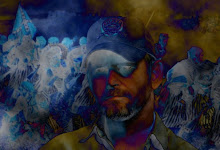Flying in marginal weather can take many forms. Ceiling and Visibility are the two big issues. Ceiling is how high a cloud layer constituting a ceiling is above the ground. Ceiling is usually measured in AGL: Above Ground Level. Visibility is the amount of distance you can see horizontally through what ever is obscuring it. Visibility is usually measured in miles and fractions of a mile. Sometimes it is given in feet.
Then to go along with visibility and ceiling you have all the weather phenomenon that tend to effect the two big issues: Rain, thunderstorms, fog, snow, ice, frontal systems, etc. The hours of darkness tend to increase the gravity of marginal weather conditions, however if you have a high ceiling and good visibility you might not even know that you are flying in rain at night unless you turn on a landing light.
Different airspace have different requirements. Military regulations differ from civilian regulations. Different companies may have more stringent weather requirements outlined in their operations manual than what the regulations require. Whether you are operating IFR or VFR changes things.
Depending on whether or not you are flying an airplane or a helicopter requirements may be different. FAR 91.155 covers the civilian side of things for Part 91 operations. In the right airspace a helicopter is allowed to legally fly in some pretty low weather conditions:
Our operations building in Korea had a cartoon poster that showed two devils looking at a radar screen showing an aircraft flying in marginal weather. One devil comments to the other devil about the aircraft they are observing, "VFR in IFR conditions... What's his ETA?"
ETA is the acronym for Estimated Time of Arrival. The two devils were anticipating new guests. The poster made its point. If you are going to mess with weather you better know what you are doing.
Korea is a mountainous land. They are not as big and majestic as the Rockies, but they are still fun to fly in and they gave me a love for mountain flying. An Army aviator is required to file and fly IFR if it is possible and will not adversely affect the mission. There was no IFR structure north of Seoul where we mainly flew and played (played is for you Ben I won't debate whether it was work or not, but I do reserve the right to take umbrage until you spend the appropriate time in the saddle playing...;-), so IFR was extremely rare in Korea. 99% of my 1200 hours in country over the two years I spent there was VFR.
I was copilot for Tim Cowan the first time I was exposed to weather. The ceilings were low, but the visibility was pretty good. We followed a lot of valleys and even rice paddies if you knew them. There was a ridge between where we were and where we needed to go. The weather that day socked in the normal pass over the ridge. Tim said there is usually more than one way to get to where you need to go. He followed the ridge to another low area he knew about that ended up being passable and we continued on on our way. Once again learning and knowing your AO (Area of Operations) was shown to me as being valuable.
It was a lot of fun, and I thought pretty cool his ability to get the job done regardless of the weather conditions. From what I observed Tim was also safe and fully in control during that whole flight. My mold was continuing to be cast...
Ciao!
Wednesday, June 2, 2010
Subscribe to:
Post Comments (Atom)







0 comments:
Post a Comment